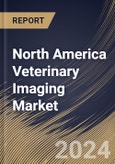A prominent trend in the veterinary imaging market is the continual evolution of technology. Advances in hardware and software contribute to developing more sophisticated imaging modalities. High-resolution imaging, faster scan times, and the integration of artificial intelligence (AI) for image analysis are among the key technological trends enhancing the diagnostic capabilities of veterinary imaging. The trend towards point-of-care imaging solutions has gained momentum, driven by the need for immediate diagnostics in various veterinary settings. Portable ultrasound devices, handheld X-ray machines, and other compact imaging solutions empower veterinarians to conduct on-the-spot assessments in emergencies, fieldwork, or clinics with limited space.
Moreover, veterinary clinics with limited space face challenges in accommodating large imaging equipment. Point-of-care imaging solutions, characterized by their compact size and mobility, address this issue. Veterinarians in smaller clinics can conduct on-the-spot assessments without requiring dedicated imaging rooms or extensive infrastructure. Portable ultrasound devices have emerged as versatile tools in point-of-care imaging. They are used for various applications, including abdominal imaging, musculoskeletal assessments, cardiac evaluations, and reproductive examinations. The versatility of portable ultrasound empowers veterinarians to address various diagnostic needs with a single, compact device.
The United States has seen a steady increase in pet ownership across the country. Dogs and cats are among the most popular pets, but there is also a growing trend of ownership of exotic animals. As people consider their pets as family members, they are more willing to invest in their healthcare, including diagnostic imaging services. Thus, the increasing pet population in North America will boost the demand for veterinary imaging in the region.
The US market dominated the North America Veterinary Imaging Market by Country in 2022 and would continue to be a dominant market till 2030; thereby, achieving a market value of $915.1 million by 2030. The Canada market is experiencing a CAGR of 8.9% during (2023 - 2030). Additionally, The Mexico market would exhibit a CAGR of 8% during (2023 - 2030).
Based on Animal Type, the market is segmented into Small Animals, and Large Animals. Based on Product, the market is segmented into Instrument (X-ray, Ultrasound, MRI, CT Imaging, Video Endoscopy, and Others), Accessories/ Consumables, and Software. Based on End User, the market is segmented into Veterinary Clinics & Diagnostic Centers, and Veterinary Hospitals & Research Centers. Based on Application, the market is segmented into Orthopedics & Traumatology, Neurology, Oncology, Dental Application, Cardiology, Respiratory, and Others. Based on countries, the market is segmented into U.S., Mexico, Canada, and Rest of North America.
List of Key Companies Profiled
- GE HealthCare Technologies, Inc.
- Agfa-Gevaert N.V. (IG Farben)
- Esaote SpA
- IDEXX Laboratories, Inc.
- Heska Corporation (Antech Diagnostics, Inc)
- Siemens Healthineers AG (Siemens AG)
- Fujifilm Holdings Corporation
- Mindray Medical International Limited
- Samsung Electronics Co., Ltd. (Samsung Group)
- Canon, Inc.
Market Report Segmentation
By Animal Type- Small Animals
- Large Animals
- Instrument
- X-ray
- Ultrasound
- MRI
- CT Imaging
- Video Endoscopy
- Others
- Accessories/ Consumables
- Software
- Veterinary Clinics & Diagnostic Centers
- Veterinary Hospitals & Research Centers
- Orthopedics & Traumatology
- Neurology
- Oncology
- Dental Application
- Cardiology
- Respiratory
- Others
- US
- Canada
- Mexico
- Rest of North America
Table of Contents
Companies Mentioned
- GE HealthCare Technologies, Inc.
- Agfa-Gevaert N.V. (IG Farben)
- Esaote SpA
- IDEXX Laboratories, Inc.
- Heska Corporation (Antech Diagnostics, Inc)
- Siemens Healthineers AG (Siemens AG)
- Fujifilm Holdings Corporation
- Mindray Medical International Limited
- Samsung Electronics Co., Ltd. (Samsung Group)
- Canon, Inc.
Methodology

LOADING...








